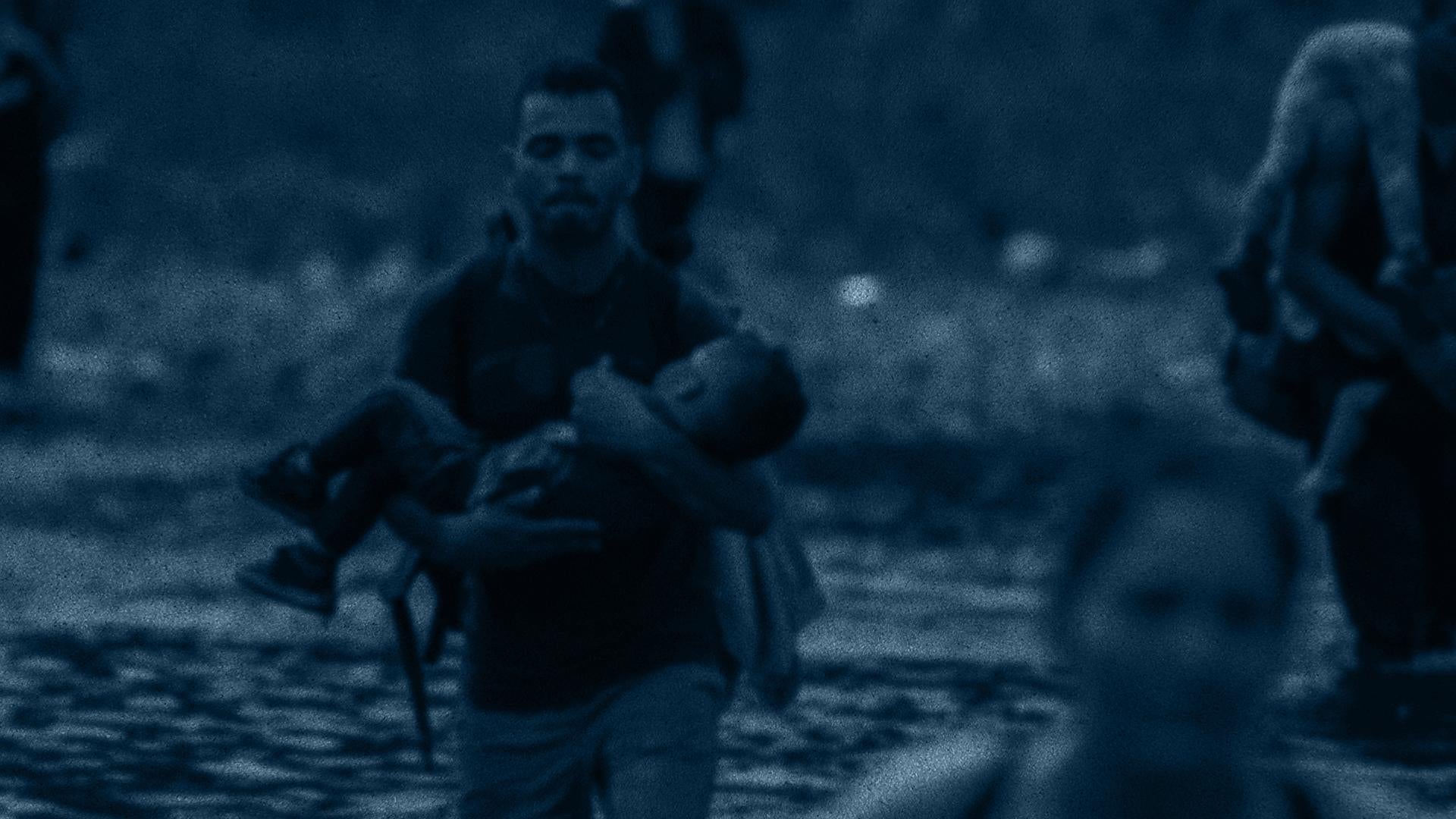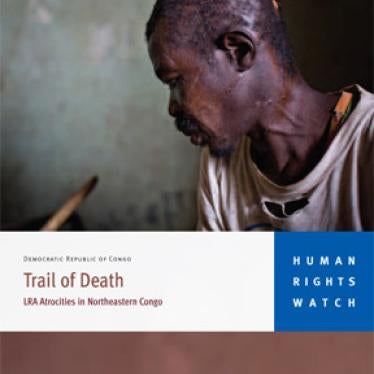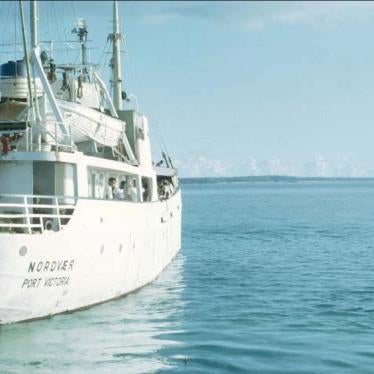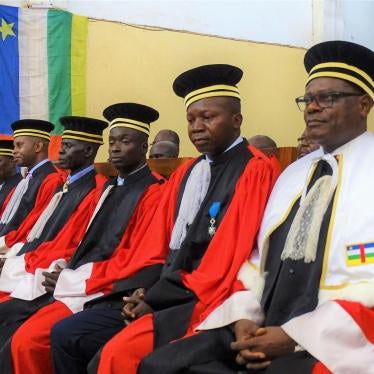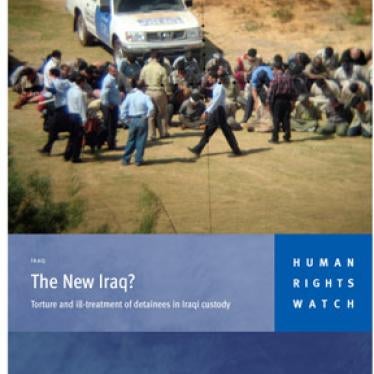The rebel Lord's Resistance Army (LRA) continues to kill civilians and abduct children in remote regions of central Africa at an alarming rate with no end in sight. Nearly three years after the LRA began its most current campaign of attacking villages and towns in the Democratic Republic of Congo, Southern Sudan, and the Central African Republic (CAR), an immense protection gap remains for hundreds of thousands of civilians who live in LRA-affected areas.
Joseph Kony and other members of the LRA's senior leadership face arrest warrants from the International Criminal Court (ICC), yet continue to commit atrocities. LRA forces attack population centers and club civilians to death and abduct children for use in their forces. Since 2008, the LRA has killed over 2,400 civilians, abducted 3,400 others, many of whom are children, and displaced over 400,000 people from their homes. Far too often, national armies and United Nations peacekeepers have left terrified civilians to face the LRA threat on their own. The lack of effective protection has meant that some areas have been attacked repeatedly, such as Doruma town in northern Congo (see below).
Joint military efforts by the Ugandan, Congolese, and Southern Sudanese armed forces, and protection measures by the United Nations peacekeeping force in Congo, MONUSCO, have not stopped LRA attacks on civilians or resulted in the apprehension of the LRA's senior leaders. Rather than confronting the failures and rethinking current strategies, Congolese and Ugandan government officials have sought to downplay the LRA threat, claiming that the LRA has been defeated. Growing distrust between the two military forces further hampers the development of adequate protection strategies. The UN peacekeeping mission in Congo, stretched between protection priorities in other parts of the country, has deployed fewer than 5 percent of its peacekeepers to LRA-affected areas. The LRA's brutal attacks on civilians are likely to continue unless more effective protection measures and greater international efforts to apprehend LRA commanders are urgently developed.
LRA Attacks on Doruma Town, Haut Uele District
Doruma town and its surroundings, tucked away in northern Congo near the border with Southern Sudan and CAR, is one of the areas hardest hit by repeated LRA attacks since 2008. On Christmas Day 2008 and in the days that followed, the LRA carried out a series of brutal attacks, killing over 300 civilians, most of whom had their skulls crushed with blows from heavy wooden clubs. Since then, attacks in the area have continued.
In April, the LRA attacked Doruma five times. The first attack was on April 19 when the LRA killed a 58-year-old man who intervened when the rebels attempted to abduct his children. The next day, the LRA attacked again, looting 20 households and abducting two brothers-ages 14 and 20-from their homes just outside Doruma. A day later, the LRA looted 11 households and abducted three more people, one of whom managed to escape. During each attack, Congolese army soldiers based in Doruma fired at the LRA assailants but did not pursue the attackers or prevent them from returning.
Humanitarian workers and residents told Human Rights Watch that fear of further attacks forced much of the population of Doruma to huddle together for safety in the center of town near the hospital and church. Some of the humanitarian workers based in Doruma were evacuated following the LRA attacks.
On April 23, MONUSCO deployed its Guatemalan Special Forces to Doruma for a six-day operation, known as Easter Shield, to protect the population. According to MONUSCO's own regulations, the deployment of its special forces should be temporary and not exceed one week. The presence of the UN peacekeepers brought temporary security and permitted people to return to their homes, but the peacekeepers withdrew on April 29. The next day, early in the morning, the LRA returned and attacked again, abducting four people who later managed to escape.
A week later, MONUSCO again deployed its Guatemalan Special Forces to Doruma who remained till May 12. Both temporary MONUSCO deployments brought some calm to Doruma when peacekeepers were present but also caused confusion. Residents and humanitarian workers interviewed by Human Rights Watch believed the peacekeepers had arrived to establish a long-term protection presence in Doruma. They were surprised, frustrated, and angry to discover that the MONUSCO peacekeeping presence was only to last a week. While Human Rights Watch has not received information about further LRA attacks following MONUSCO's withdrawal on May 12, the need for a sustainable protection solution for the population in Doruma is evident. According to local and other sources, LRA combatants remain in the vicinity of Doruma and the population remains terrified of renewed LRA attacks.
Since the Christmas massacres of 2008 and other attacks in the Doruma area, as well as the continued presence of LRA combatants, Human Rights Watch, Congolese civil society, and humanitarian agencies have consistently urged the UN to set up a peacekeeping presence in Doruma and enhance protection measures for the population. Other than the two one-week deployments, no such measures have occurred. UN officials at first claimed there were logistical problems due to the soft airstrip, its distance from other UN bases, and difficulties accessing Doruma by road-a limitation less valid now that the road from Doruma to Dungu is passable. They also argued that it was not necessary to set up a UN base because the Congolese army was present in Doruma.
The Congolese army had deployed troops to Doruma in early 2009 but most were later redeployed elsewhere. Today, there are an estimated 100 soldiers based in Doruma from the Congolese army's 913th Battalion. This presence has been inadequate at protecting the population, as evidenced by the series of attacks in April. The Ugandan army had a temporary presence in Doruma in late 2008 and early 2009, but its base was removed a few months later.
UN peacekeepers should coordinate with Congolese and Ugandan officials to urgently devise sustainable and effective protection measures for Doruma and the surrounding area.
LRA Attacks Near Pasi and Zangabai Towns, Bas Uele District
Another area suffering repeated attacks is around the towns of Pasi and Zangabai, in northeastern Bas Uele district, just south of the border with CAR. The neighboring towns are along a route frequently used by the LRA since 2008. During a fact-finding mission to the area in March and April 2011, Human Rights Watch documented 25 previously unreported attacks by the LRA in the area since 2009. During these attacks, the LRA abducted 166 civilians, killed 9 others, and wounded many more. Over 1,000 people fled their homes to seek safety elsewhere.
Traumatized civilians in and around Pasi and Zangabai rely on just 12 Congolese soldiers deployed in the two towns to protect them from the LRA. The soldiers have little ammunition and no means of transportation or communications with their commanders in Doruma, several days away on foot. When the LRA attacks, the soldiers are often forced to flee along with the population.
The residents' feelings of abandonment were palpable when Human Rights Watch visited these towns in late March. A 45-year-old farmer from Zangabai told Human Rights Watch that his four sons, ages 4 to 18, were abducted by the LRA when the rebels attacked and burned his home in November 2010. A woman who was a captive of the same LRA group later escaped and reported that two of the farmer's boys had been killed by the LRA in the forest. The visibly traumatized man, his body shaking while he recounted to Human Rights Watch what happened to his sons, pleaded to the international community for assistance:
We have sad hearts knowing that we've been forgotten and live here at the mercy of these rebels. We have no medicine, and we can't go to our farms because of the insecurity. I wish the international community would look at what's happening and realize that we're humans too.
A 79-year-old man from Longondo was pierced with a bayonet just above his right eye by LRA combatants who had abducted him and 17 others in April 2010. He was released after two days and fled to Zangabai, 20 kilometers east of his home. In January 2011, the LRA attacked Zangabai, killing a 5-year-old boy and abducting a 30-year-old woman. In late February, the elderly man witnessed the abduction of a 27-year-old man who remained missing a month later when a Human Rights Watch researcher visited Zangabai.
"The last time the LRA attacked here was a week ago," he told Human Rights Watch. "They shot at a boy, but they missed and he was able to flee. The soldiers then fired at the LRA and the LRA fled. People here are scared because there are only a few soldiers based on the other side of town. If the LRA attacks on our side of town, we have no protection."
The LRA has repeatedly attacked these two remote towns and the surrounding area since 2008, yet not a single UN peacekeeper or humanitarian agency has visited the area since the attacks began. In August 2010, Human Rights Watch reported that the LRA was conducting a massive abduction and killing campaign in Bas Uele district and called on MONUSCO to urgently deploy peacekeepers to the area to protect civilians and assist efforts to rescue the abductees. In December, MONUSCO set up a temporary base in the town of Ango, in western Bas Uele district, with a small contingent of peacekeepers. They carried out minimal patrols, and failed to reach areas to the north and east of Ango most affected by LRA attacks. The peacekeepers left Ango three weeks after arriving. Since then, there have been no further attempts to set up a base in Bas Uele district. According to some UN officials and other military experts, the LRA's top leader, Joseph Kony, is suspected to have entered Bas Uele district in early 2011. At the time of writing, many believe he may still be there.
Identifying the LRA
Reports from those who have recently escaped the LRA, often after spending months in captivity, confirm that the LRA's trademark abuses continue. A 20-year-old woman from Naparka, Haut Uele, told Human Rights Watch that her sister and other abductees were killed in November in one of the LRA's brutal initiations:
A group of four LRA captured my little sister and me from our home and took us into the bush with them. We met a huge group of LRA combatants near the Gurba River, along with more than 100 Congolese who had been captured earlier, mostly children between 10 and 15 years old. Soon after we arrived, the LRA made some of these children kill my younger sister. They tied her up and then crushed her skull with a heavy wooden bat. Four other abducted women from Banda were killed in the same way. Then I was given to an LRA combatant to be his wife. The LRA were very well armed with AKs [AK-47 assault rifles] and machine guns. Sometimes the Ugandan army shot at us, but the LRA fired back and none of them were ever killed.
An 18-year-old woman who was abducted by the LRA during the attack on Bambangana in February told Human Rights Watch of her ordeal before she managed to escape two weeks later:
I was taken to three different LRA camps, each one bigger than the one before. In the last camp, there were dozens of LRA combatants and more than 100 abducted girls and boys from other villages. The one order they gave us was that we couldn't escape. If we tried to flee, they would kill us.
Based on her description and prior research by Human Rights Watch and others, the commander of the second camp where she was held was probably David Lakwo. He has a conspicuously scarred mouth, which other witnesses have often described to Human Rights Watch, and was reported by others as being in the area. David Lakwo was one of the senior commanders responsible for a massive abduction campaign in Bas Uele district in 2009 and early 2010 (see "CAR/DR Congo: LRA Conducts Massive Abduction Campaign," Human Rights Watch news release, August 11, 2010). There were reports of his death in mid-2010, but this testimony and others indicate he may still be alive.
The young woman described the commander of the third camp, "Dominic," as the chief of all the other commanders in the area. Human Rights Watch believes that this was possibly Dominic Ongwen, one of the top LRA leaders sought on an ICC arrest warrant. Just before her escape, she and dozens of abducted children were told that they would be taken next to the "supreme leader's" camp. "They said we would walk for one month and two weeks to get there," she told Human Rights Watch. "And then they would drug us and perform initiation ceremonies so we would forget our lives back home." Dominic Ongwen and troops under his command have repeatedly terrorized communities in Haut Uele district and are responsible for some of the LRA's most brutal attacks, including the Makombo massacre in December 2009 in which at least 345 civilians were killed and another 250 abducted. (See Human Rights Watch, Trail of Death, March 2010.)
The presence of known LRA commanders among the attackers is further evidence that these attacks are being carried out by the LRA and not by bandits or other groups, as sometimes claimed by Congolese authorities.
Failure to Arrest LRA Leaders and Protect Civilians
Congolese and Ugandan efforts to apprehend the LRA leadership and protect civilians have suffered from a public campaign by Congolese authorities to play down the LRA threat, high levels of mistrust between the two forces, and increasing disenchantment by Congolese officials and ordinary civilians with the Ugandan army presence. These problems were exacerbated by the Ugandan army's decreased presence in the LRA-affected areas. Ugandan authorities withdrew an estimated 3,000 troops from the LRA operation between 2009 and 2011, possibly to focus on competing priorities such as the African Union peacekeeping mission in Somalia, elections in Uganda and quelling ongoing domestic protests. An estimated 1,500 Ugandan troops remained behind.
Minimizing the LRA threat and blaming others
Congolese government and military authorities have carried out a public information campaign that seeks to minimize the LRA threat, despite the alarming levels of LRA violence in northern Congo. Authorities in Kinshasa, the capital, and in Orientale province have even sought to deny any significant LRA presence, repeatedly claiming both publicly and in private meetings with Human Rights Watch and others that 20 or fewer combatants remain in the country.
On March 18, for example, the Congolese defense minister, Mwando Simba, announced during an official visit to Dungu and Faradje, in Haut Uele district, "We can speak about 10 or 20 [LRA combatants active in Congo], I maintain this position.... The improvement is clear, but we can't let down our guard."
Congolese army officers in Dungu later explained to visiting delegations, including from the African Union, and during an interview with Human Rights Watch, that precisely 12 LRA combatants remained in Congo. This figure is based on a questionable calculation, subtracting the number of LRA combatants reported to have been killed or neutralized from the Ugandans' official estimate of the number before the joint operations began. Both sets of figures have been highly contested. The calculation also fails to consider how many of the experienced LRA commanders still remain and the new LRA recruits and abductees who have replenished the ranks.
Through these reports, Congolese authorities have not only played down LRA abuses against civilians, but also the losses by poorly equipped and supported Congolese soldiers in LRA-affected areas. Instead the authorities have blamed local bandits, nomadic cattle herders known as the Mbororo, or Ugandan soldiers for recent attacks. In late January, a Congolese military officer in Dungu called on civil society to stage a public protest against the presence of Ugandan forces, who he announced were responsible for a January 15 ambush, a claim all other sources denied. The authorities appear to be appealing to voters across the country in an election year and pressuring the Ugandan army to leave Congolese soil. Presidential and parliamentary elections in Congo are slated for November.
The Ugandan army leadership has also routinely denied that the LRA has the capacity to carry out serious attacks against civilians, frequently arguing that they are a "spent force." On April 30, Ugandan President Yoweri Museveni claimed in a statement appearing in the government newspaper, The New Vision, "We defeated Kony."
Tensions between Congolese authorities and the local population
The Congolese government's denials of the LRA threat have sparked several local demonstrations in the Uele districts by people who feel abandoned, their suffering and fear of the LRA ignored even by their own leaders. In some cases, Congolese government and military authorities have intimidated and censored civil society members to limit their criticism of the government, pressuring them to seek official approval before making any public statements, and threatening them that there would be consequences if they continue to speak out about ongoing LRA attacks.
A protest in Dungu on January 25 turned violent when local youth threw stones at UN peacekeepers and Congolese policemen, whom they blamed along with government authorities for not doing more to protect them from LRA attacks. Local government authorities and policemen were unable to contain the demonstration or intervene. Similar protests followed in Isiro, Faradje, and other towns, some of which also became violent. Local government authorities and police or military personnel were often unable or unwilling to intervene or respond to the demonstrators' demands; in some cases they manipulated local populations to turn their anger toward UN peacekeepers instead of local authorities.
As one religious leader in Haut Uele told Human Rights Watch:
A big tension exists between civil society and our government and military authorities. We, civil society, we feel the LRA attacks and we live their consequences on a daily basis. We listen to the testimonies of those who have escaped the LRA and we witness the abductions, the killings, the ambushes, and the attacks on villages. Can we naively accept the Congolese army's claims and denials? If our leaders don't start understanding that we are dying here, the persistent tension between the population and our government may escalate even further, at the risk of becoming violent. We will protest, launch demonstrations, organize marches, and do what it takes to get them to notice us.
Another civil society leader in Haut Uele said, "The population is tired of this suffering. What worries us most is when we listen to the media and hear declarations from our authorities about how the LRA is no longer a threat. This really hurts our hearts."
Mistrust between Congolese and Ugandan military authorities
Mistrust between the Congolese and Ugandan armed forces has hampered coordination and cooperation between them, frequently keeping Ugandan forces from sharing key intelligence or their operational plans, UN sources and Congolese army officers said. Congolese military authorities, for their part, have denied Ugandan forces access to certain areas, in some cases preventing them from following through on pursuit operations against LRA leaders. For instance, on January 16, Congolese authorities denied the Ugandan army permission to send an intercepting force to Banda to go after the LRA leader Joseph Kony and his forces after they reportedly moved into Ango territory, Bas Uele district. One explanation is that it was to prevent the Ugandan forces from seeing or interfering in the killing and cattle theft against the Mbororo then going on by Congolese forces under Lt. Col. Nelson Mugabo.
Cooperation has also been undercut by the increasing disenchantment by Congolese authorities and local residents with the Ugandan military presence. They point to former LRA fighters in the Ugandan army, recent abuses by Ugandan soldiers, the Ugandan army's abusive and exploitative history on Congolese soil as an occupying power between 1998 and 2003, and what they claim are relatively small Ugandan army casualties, which suggest to them that Uganda is not serious about going after the LRA.
Not a Priority for UN Peacekeepers
The UN peacekeeping force in Congo, MONUSCO, has just over 17,000 peacekeepers deployed throughout the country, but fewer than 1,000 are deployed in LRA-affected areas in northern Congo, and none are based in Bas Uele district where Kony and other senior LRA leaders have recently been operating. MONUSCO says that its force is too stretched and it has given priority to the protection of civilians in the Kivu provinces of eastern Congo. The UN Security Council has also paid little attention to the LRA problem, has rarely debated the issue, and has not authorized additional resources for MONUSCO to better address the protection threat.
Not only are too few UN troops deployed in the LRA-affected areas, but those who have been deployed are ill-equipped to address the LRA threat. MONUSCO faces a serious shortage of well-trained and -equipped peacekeepers, intelligence analysts, interpreters, helicopters, and military assets such as fire support. In late April, MONUSCO provided logistical support to the deployment of additional Congolese army troops to the LRA-affected area of northern Congo; the new troops have recently completed training by the US government. It is not clear if the Congolese troops will be appropriately equipped.
The peacekeeping mission's response to the LRA threat is further weakened by having only a very small number of senior-level MONUSCO staff based in or near LRA-affected areas with an insufficient number of dedicated political advisors and military liaison officers. MONUSCO's establishment of a Joint Information and Operations Cell (JIOC) in Dungu, while a positive step forward, is an example of an initiative that has suffered due to a lack of adequate resourcing and senior staff. As a result, MONUSCO is unable to use its good offices to enhance cooperation and manage tensions between the Ugandan and Congolese armies.
MONUSCO has also sought to extend its protection strategy of "protecting by presence" into LRA-affected areas, even though the LRA's tactics and behavior are substantially different from armed groups in other parts of Congo. The mere presence of MONUSCO peacekeepers, which has contributed to deterring attacks on civilians in the Kivu provinces of eastern Congo, has been less effective in LRA-affected areas. MONUSCO officials often refer to "protection bubbles" around their bases, but in reality these bubbles cover a very limited area. The extent of MONUSCO's presence can be expanded by active patrolling and pursuit operations following attacks, but this has been more difficult in LRA-affected areas where roads are often in a very poor state. MONUSCO commanders interviewed by Human Rights Watch repeatedly say they are able to do little more than protect the UN's own bases. MONUSCO has not adapted to this environment nor shown flexibility by adding patrols using motorcycles or all-terrain vehicles, a strategy that could substantially expand their effective presence. When peacekeepers do go on patrols, they often stay on main roads and follow patterns that are easy for LRA forces to avoid.
In at least five cases in the past 12 months, according to Human Rights Watch research, the LRA has successfully carried out attacks in extremely close proximity to a MONUSCO base. In one such attack on August 28, 2010, a Human Rights Watch researcher was present in Duru, Haut Uele district, when the LRA attacked less than 500 meters from MONUSCO's Company Operating Base (COB), which housed 200 peacekeepers. The UN commander was informed within hours of the abduction of eight civilians by five LRA combatants. No special patrols were sent to the site of the attack, nor were any clear actions taken by the peacekeepers to pursue the assailants. That night, the LRA brutally stabbed and killed three of the young men they had abducted. The following day, a regular vehicle patrol was dispatched by MONUSCO as per the usual schedule. A woman and 16-year-old girl released by the LRA the morning after the attack told Human Rights Watch that their captors had given them a message for the Congolese army and others in Duru: "We are nearby, and we will be back soon."
Human Rights Watch research in LRA-affected areas over the past three years, including numerous interviews with MONUSCO officials occupying a wide range of civilian and military posts, and our own observation of MONUSCO actions, expose serious gaps that undermine the mission's ability to protect civilians. MONUSCO's capacity to collect and analyze intelligence in the LRA-affected areas, its ability to flexibly respond to changed circumstances, to communicate effectively across the mission and across borders with other UN agencies in CAR and Southern Sudan, and to interact and coordinate with humanitarian agencies, civil society, and religious leaders-all of whom are potential sources of information on recent attacks and the LRA's whereabouts-is deficient.
Conclusions and Recommendations
Over the past 25 years, numerous strategies have been tried to end or effectively contain the threat posed by the LRA. These strategies have failed. While the number of LRA combatants has fluctuated over the years, the force's ability to attack civilians remains undiminished. As described above, current operations to tackle the LRA threat too closely resemble, in spirit and in substance, past ineffective attempts. If the United States, UN Security Council, and other concerned actors are serious about giving meaning to international justice and protecting civilian populations at grave risk, then urgent new measures are required that move away from current unsuccessful tactics.
Such a solution will require concerted collaborative efforts on the part of the regional governments most concerned-the Democratic Republic of Congo, the Central African Republic, Southern Sudan, and Uganda-as well as by the United States, the African Union, the European Union, and regional UN peacekeeping missions. It will also require much greater attention and flexibility by the UN Security Council and the UN Department of Peacekeeping Operations (DPKO) to help provide effective protection for the civilian population at risk of LRA attacks.
Two elements are key to help end the LRA threat and protect civilians at risk:
1. Greater and more effective protection of civilians
The UN Security Council and the DPKO should urgently revisit their response to the LRA and address the protection gaps in eastern CAR as well as much of northern Congo, including Bas Uele district. This will require a greater number of peacekeeping troops in LRA-affected areas, changes in operating procedures and force capabilities to ensure that peacekeeping troops adapt to their environment, and the deployment of senior-level civilian staff members to the LRA-affected regions to lead efforts to respond to the LRA threat. UN member states should ensure that the necessary personnel, resources, and equipment are made available to respond to these needs.
Protection work should also include bolstering efforts to establish early-warning mechanisms, rescue abducted children and adults, improve voluntary disarmament and demobilization programs, and increase humanitarian assistance to civilian populations.
2. Enhanced efforts to apprehend the LRA's top leaders
Greater efforts to protect civilians should be combined with enhanced efforts to apprehend LRA leaders. The LRA operates across a large, isolated area where military operations are difficult to undertake. Yet much about the LRA's structure, capabilities, and the leaders' approximate locations are often known to governments in the region, the UN, and nongovernmental organizations active on the issue. What has been lacking to date are the appropriate means and will to put this information to use in a timely and effective manner by states capable of conducting a law enforcement operation to apprehend the LRA's leaders sought on ICC arrest warrants.
The UN Security Council, the United States, and other concerned actors should make the commitment necessary to ensure that capable forces are deployed to pursue the LRA's top leaders sought on arrest warrants by the ICC. To deter retaliatory attacks by the LRA, all plans to pursue the LRA's top leaders should be undertaken only when effective resources and personnel are deployed to adequately protect civilians in the affected areas.
